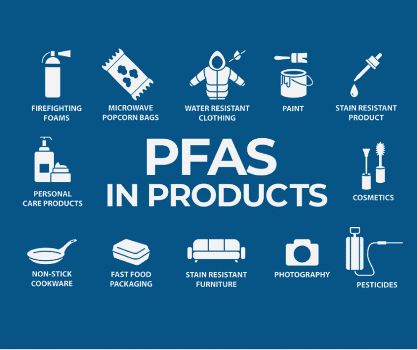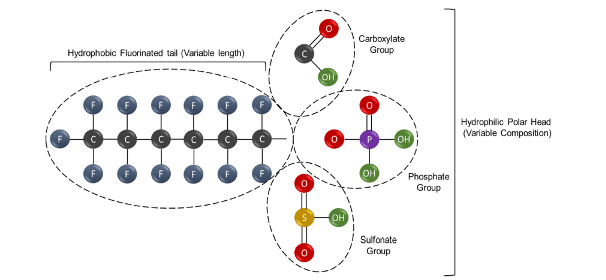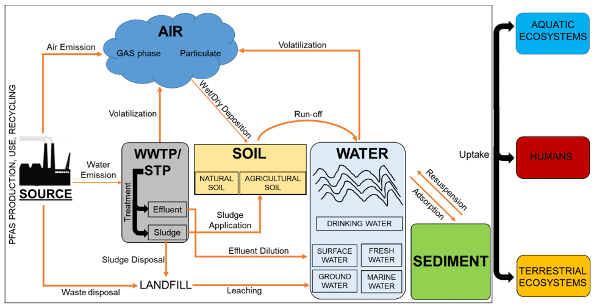Call us Monday to Friday, 9am to 5pm:
📞 +32 471 36 77 09

By Nicolas Bekaert, founder of Aquacycle
Per- and polyfluoroalkylated substances (PFAS) are a vast group of synthetic chemicals - there are over 4,700 of them - used on a massive scale since the 1940s in industry, commerce and consumer products.
Entirely man-made, these substances do not occur naturally. PFASs feature extremely strong carbon-fluorine (C-F) bonds, among the strongest in organic chemistry. This makes them highly resistant to heat, chemicals and environmental degradation. Because of this persistence, they are often nicknamed "Eternal pollutants (forever chemicals).

PFAS are highly prized for their unique physico-chemical properties: they are both water- and oil-repellent, and highly resistant to high temperatures, stains, grease and corrosion. Their versatility explains their presence in over 100 sectors, including non-stick cookware, waterproof textiles, fire-fighting foams, food packaging, pesticides, cosmetics, medical devices, electronics, aeronautics and construction. Annual worldwide production of certain PFAS - such as fluoropolymers - reaches several hundred thousand tonnes.

What makes PFAS particularly worrying is that they do not degrade naturally. Surprisingly, there is still no universally accepted definition of PFASs, which complicates their regulation. Yet their ubiquity, durability and potential toxicity put them at the heart of environmental and public health debates.
La pollution par les PFAS ne provient pas d’une seule source — elle en a plusieurs.
One of the most important is the industry. For decades, factories have been releasing PFASs such as PFOS or PFOA into the air, water or soil, particularly during manufacturing processes.
Another major source is fire-fighting foamThese are used in airports, military bases and training centers. These foams (called AFFF) contain PFAS, which leach into the soil and contaminate groundwater.
Visit everyday products containing PFAS - non-stick pans, water-repellent textiles, food packaging - also become sources of pollution when they are thrown away. In landfills, PFAS can escape slowly and pollute nearby soil or water. They can even travel through the air and settle on the ground. far from their point of origin.
This European map lists sites already confirmed as contaminated by PFAS. Yet much of this pollution remains invisible. Analyses are expensive, and many areas simply don't have never been tested. What we see today is undoubtedly only the tip of the iceberg.
PFAS are both very persistent and extremely mobile.
They do not decompose easily in nature and can travel very long distances via the wind, rain, rivers or oceans. They have even been found in isolated regions such as the Arctic and Antarctic.

Today, experts estimate that over 100,000 sites in Europe could be affected by PFAS discharges - factories, landfills, airports, wastewater treatment plants, etc. These sources are at the root of the widespread contamination we are only now beginning to understand.
L’eau est l’un des principaux vecteurs des PFAS vers l’environnement et, par extension, vers nos corps.
PFAS dissolve in water and spread easily via the rivers, water tables and lakes. This makesdrinking water one of the main modes of exposure for the population. Even at low doses, regular consumption can lead to heavy accumulation in the blood It is estimated that regular consumption of water containing PFOA (a PFAS subgroup) can lead to high blood levels. up to 100 times higher to those present in water.
Visit fish and seafood are categorized as the most contaminated food source due to biomagnification. PFAS accumulate in their tissues as they live in polluted waters. The larger the species (eating smaller fish) or the longer they live, the higher the concentration. And since seafood products are widely consumed, this constitutes a direct route of contamination for humans.
A major study published in 2024 in the journal Naturebased on over 17,000 food samples, revealed that :
PFASs therefore spend factories and landfills at riversto fieldsto oceans...then on our plates and in our glasses.
PFAS are now present everywhere - in the environment and in food.
Le vrai problème, c’est qu’une fois dans le corps, les PFAS s’accumulent avec le temps. Notre organisme ne sait pas les éliminer efficacement. Résultat : même de petites expositions répétées peuvent entraîner des niveaux élevés dans le sang.
Research shows that PFAS can have serious health effects. Among the risks identified :
Although not all PFASs have yet been studied, scientists agree that caution is the order of the day. With thousands of different substances, it's hard to know which are the most toxic - a real headache for health authorities.
For decades, PFAS have made our daily lives easier: nonstick frying pans, waterproof textiles, resistant packaging... But today, we know that these products also have an impact on the environment. dark side They endanger our health and the environment in the long term.
One of the main challenges is that thousands of different PFASbut only a few, such as PFOA and PFOS, have actually been studied. At present, only 20 types of PFAS are systematically analyzed in European drinking water. Although these are identified as the most worrying, it is little compared to 4 700 that we know exists.
Given the extreme persistence of these substances and the uncertainty about their effects, many experts are calling for apply the precautionary principle Limiting the use of PFAS even if we don't yet know all the risks.
> What you can do at your level :
PFAS is a global challengeBut thanks to awareness, scientific advances and ambitious political decisions, we have the means to start solving this problem.
Sources :
AQUACYCLE
Pure water you can trust
💧 Pure water you can trust
💧 Water filtration experts in Brussels
💧 Sale of systems & filters
@aquacycle.be
Take advantage of 30 minutes with an expert to answer all your questions.